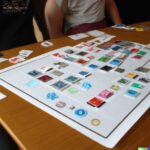Are you ready to put your detective skills to the test? Learn how to play Clue, the classic mystery board game that has been entertaining players for generations.
In this article, we’ll guide you through the basics of the game, from setting up the game board and selecting characters to understanding the rules and gathering clues. Whether you’re a newcomer to the world of Clue or looking to brush up on your strategic gameplay, this guide will help you master the art of solving the ultimate whodunit.
Clue is a thrilling game that challenges players to solve a mysterious murder by gathering clues, making suggestions, and ultimately identifying the culprit, weapon, and location of the crime. With its intricate gameplay and suspenseful plot, Clue guarantees an exciting experience for players of all ages. If you’ve ever been curious about how to play this beloved board game or simply want to enhance your gameplay, read on for an in-depth look at every aspect of Clue.
In this section of our guide, we’ll provide an introduction to Clue: The Classic Mystery Board Game. From a brief history of the game’s origins to an overview of its key features and objectives, you’ll gain a comprehensive understanding of what makes Clue such a timeless favorite among board game enthusiasts. With our step-by-step instructions and expert tips, you’ll be well-equipped to embark on your own thrilling journey into the world of Clue.
Setting Up the Game
Before diving into the thrilling world of Clue, it’s essential to understand how to set up the game properly. This involves familiarizing yourself with the game board and pieces, ensuring that everything is in place for an enjoyable gaming experience.
Understanding the Game Board and Pieces
The Clue game board features nine rooms, each with its own unique color and name. The iconic rooms include the Hall, Lounge, Dining Room, Kitchen, Ballroom, Conservatory, Billiard Room, Library, and Study. In addition to the rooms, there are also various secret passages that allow players to move from one room to another quickly.
The game also comes with several sets of cards: suspect cards (depicting characters), weapon cards (showcasing potential murder weapons), and room cards (illustrating the different locations in the mansion). These cards play a crucial role in determining who committed the murder, where it took place, and with what weapon. Each player will receive a set of these cards at the beginning of the game to help them solve the mystery.
Overall, understanding the layout of the game board and familiarizing yourself with all of its components is essential before starting a game of Clue. Once everything is set up correctly and everyone has chosen their character tokens, it’s time to begin unraveling the enigma behind Mr. Boddy’s untimely demise.
Selecting Characters
When playing Clue, selecting your character, or suspect, is an important decision that can impact your overall gameplay. Each character has their own unique strengths and weaknesses that can affect how you navigate the game board and gather clues. Here are some tips on how to choose your suspect wisely.
Understanding Character Abilities
In the classic version of Clue, each character has their own special ability. For example, Miss Scarlett is able to move additional spaces on her turn, while Colonel Mustard can make a suggestion from one space farther away. It’s important to take these abilities into consideration when choosing your suspect, as they can give you a strategic advantage during the game.
Personal Preference
While the abilities of each character are important, it’s also okay to choose your suspect based on personal preference. Whether you prefer Mrs. Peacock’s iconic blue color or Professor Plum’s sophisticated look, feeling connected to your character can enhance the overall enjoyment of the game.
Strategic Pairing
If you’re playing with others who have already chosen their suspects, it can be strategic to pair your selection with certain characters. For example, if someone else has chosen Miss Scarlett for her ability to move additional spaces, you may want to select a character like Professor Plum who has a different set of abilities that complement Scarlett’s. This way, you can cover more ground and gather clues more efficiently as a team.
Understanding the Basics
Clue, also known as Cluedo, is a classic mystery board game that requires players to use deductive reasoning and logic to solve a murder mystery. The objective of the game is to be the first player to correctly determine the suspect, weapon, and room involved in the murder. Players must gather clues by moving from room to room, making suggestions, and using the process of elimination to solve the mystery.
The game is typically played with 3-6 players, each taking on the role of a different character. The characters include Miss Scarlet, Professor Plum, Colonel Mustard, Mrs. Peacock, Mr. Green, and Mrs. White. Each player will move their character token around the game board to investigate different rooms and make suggestions about the possible suspects, weapons, and locations.
In order to win the game, players must make an accusation by stating the suspect, weapon, and room they believe are involved in the murder. If their accusation is correct based on their collected clues, they win the game.
However, if their accusation is incorrect, they are out of the game but can still participate by answering other players’ suggestions with their own evidence cards. This adds an element of suspense and strategy as players try to outwit their opponents while solving the mystery.
Gathering Clues
When playing Clue, one of the most crucial parts of the game is gathering clues by exploring the rooms and collecting evidence. The game board represents the layout of a mansion, which consists of different rooms where players can move their character pieces to gather information. Each room has its unique set of items that can serve as potential clues to solve the mystery.
To start gathering clues, players must strategically move their character pieces around the mansion to enter different rooms. Once inside a room, they can make suggestions about the suspect, weapon, and room they believe are part of the solution to the mystery. This allows them to gather information by observing other players’ reactions or receiving cards from other players that may confirm or disprove their suspicions.
In addition to moving around and exploring rooms, players also have the opportunity to collect evidence through secret passages located on the game board. These passages allow characters to move quickly from one area of the mansion to another, providing them with additional opportunities to gather clues and solve the mystery faster than their opponents. Mastering the art of exploring rooms and collecting evidence is essential for deducing who committed the crime, with what weapon, and in which room.
Making Suggestions
After moving into a room, a player can make a suggestion. When making a suggestion, the player must name the suspect and the weapon they suggest was used in that room. The player then secretly looks at the card of the player to their left. If that player holds any of the three cards mentioned in the suggestion, they must show one (and just one) of them to the suggesting player.
To make an effective suggestion in Clue, it is important to pay attention to which cards other players are showing or not showing. This can help narrow down which cards might be in the solution envelope and contribute to solving the mystery. Keep track of what cards have been shown so you can eliminate those possibilities from your own inquiries.
It’s also important to use logical deduction when making suggestions. Consider not only which cards others are showing, but also where they have been on the board and what they may have learned from prior suggestions. Taking note of these details will help you unravel the mystery and ultimately lead you closer to victory.
- Use logical deduction when making suggestions
- Keep track of which cards other players show
- Pay attention to where other players have been on the board
Solving the Mystery
Once you have gathered enough clues from exploring the rooms and making suggestions, it’s time to start piecing everything together on your clue sheet. The clue sheet is a crucial component of the game as it helps you keep track of the information you gather and narrow down the possibilities to solve the mystery. Each player has their own clue sheet, which they fill out as they gather more information throughout the game.
On your clue sheet, there are sections for each suspect, weapon, and room. As you gather clues, you can mark off which ones are not part of the solution based on what you know. This process helps narrow down your options and eventually lead to your accusation. Keeping an organized and clear clue sheet will improve your chances of solving the mystery before your opponents do.
It is important to pay attention to other players’ suggestions and try to deduce what cards they might have based on their reactions during the game. This will help you eliminate possibilities from your clue sheet and get closer to identifying the true culprit. Utilizing the clue sheets effectively requires strategy, critical thinking, and deduction skills – all valuable elements in winning at Clue.
| Aspect | Description |
|---|---|
| Clue Sheet Sections | Sections for each suspect, weapon, and room for marking off possibilities |
| Organizational Skills | Importance of keeping an organized and clear clue sheet for better decision-making |
| Player Reaction Analysis | Paying attention to other players’ reactions during the game to help eliminate possibilities from your clue sheet |
Tips and Strategies
Clue, the classic mystery board game, requires a combination of strategy, deduction, and a bit of luck to outsmart your opponents and solve the mysterious murder. Here are some tips and strategies to help you master the game and increase your chances of winning:
- Keep track of information: As you gather clues and make suggestions, it’s important to keep track of the information that is revealed to you. Use the notepad provided in the game to jot down which cards other players show you, as well as any deductions you make about which cards they hold.
- Make strategic suggestions: When making suggestions, try to strategically choose rooms that will benefit you the most. If there are multiple cards in your hand for a particular room or weapon, suggest that room to see how other players react. This can help you deduce which cards they might be holding.
- Bluffing and misdirection: Use bluffing and misdirection to throw off your opponents. You can purposefully suggest a card in your hand that you don’t actually have, in order to confuse other players and lead them away from the true solution.
By using these tips and strategies, along with careful observation and deduction, you can increase your chances of solving the mystery in Clue and emerge victorious against your opponents. Remember that while luck plays a role in the game, mastering these tactics can greatly improve your gameplay experience.
Conclusion
In conclusion, Clue is a timeless classic that provides endless fun for players of all ages. The thrill of solving a mystery, the strategic gameplay, and the element of surprise make it a beloved board game for many. Whether you’re a beginner or a seasoned Clue player, there’s always something new to discover and enjoy with each game.
The beauty of Clue lies in its ability to bring people together for an evening of entertainment and intrigue. The game encourages critical thinking, deduction, and collaboration as players work to solve the mystery. It’s also a great way to bond with friends and family, creating lasting memories and fostering healthy competition.
So, gather your fellow sleuths, set up the game board, and let the mystery unfold. With its classic charm and engaging gameplay, Clue continues to captivate players around the world. Get ready to put on your detective hat and immerse yourself in the world of Clue – where every game brings a new adventure and guarantees hours of thrilling entertainment.
Frequently Asked Questions
How Do You Play Clue Classic Edition?
To play Clue Classic Edition, each player takes on the role of one of the game’s colorful characters and moves around the board trying to solve the mystery of who killed Mr. Boddy, with what weapon, and in which room. Players collect various clues by moving from room to room and making suggestions about the murderer, weapon, and location.
The goal is to be the first player to correctly guess all three aspects of the murder.
How Do You Play the Board Game Clue Mystery?
In the board game Clue Mystery, players also take on the roles of different characters and move around a mansion trying to solve a murder mystery. As in the Classic Edition, players gather clues by entering different rooms and making suggestions about possible suspects, weapons, and locations. The first player to make an accurate accusation wins the game.
What the 80s Clue Mystery Game Was Played On?
The 80s Clue Mystery Game was played on a game board representing a large mansion with various rooms where players can move their character pieces in order to gather clues and attempt to solve the mystery. The game has cards representing suspects, weapons, and rooms that are used to provide clues for solving the murder mystery.
It also includes dice for movement and other components typical of board games from that period.

I love playing all kinds of games – from classics like Monopoly to modern favourites like Ticket to Ride.
I created this blog as a way to share my love of board games with others, and provide information on the latest releases and news in the industry.





